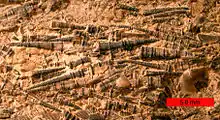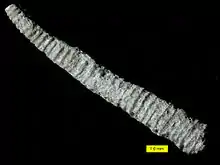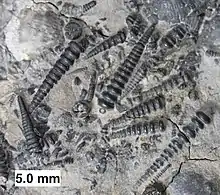Tentaculites
Tentaculites is an extinct genus of conical fossils of uncertain affinity, class Tentaculita, although it is not the only member of the class. It is known from Lower Ordovician to Upper Devonian deposits[1] both as calcitic shells with a brachiopod-like microstructure[2] and carbonaceous 'linings'.[3][4] The "tentaculites" (i.e. tentaculita) are also referred to as the styliolinids.
| Tentaculites Temporal range: | |
|---|---|
 | |
| Tentaculitids from the Devonian of Maryland. | |
| Scientific classification | |
| Domain: | Eukaryota |
| Kingdom: | Animalia |
| Class: | †Tentaculita |
| Order: | †Tentaculitida |
| Family: | †Tentaculitidae |
| Genus: | †Tentaculites von Schlotheim, 1820 |
Affinity
The taxonomic classification of tentaculitids is uncertain. Some grouped them with pteropods, but there is no modern support and only superficial similarity.[5] They may also be related to other conical shells of uncertain affinity including cornulitids, Anticalyptraea, microconchids and trypanoporids.[6] Their shell microstructure has warranted their comparison with the brachiopods and phoronids,[2][7] and the possible Ediacaran lophophorate Namacalathus.[8]
Morphology



Tentaculitids have ribbed, cone-shaped shells which range in length from 5 to 20 mm. Some species septate; their embryonic shell, which is retained, forms a small, sometimes spherical, chamber.[4]
Ecology
Some species are inferred to have been planktonic.[9]
See also
- Mari Mari Group, fossil formation in the state of Amazonas of northwestern Brazil
References
- Traverse, A. (2007). "What Paleopalynology Is and Is Not". Paleopalynology. Topics in Geobiology. Vol. 28. pp. 1–43. doi:10.1007/978-1-4020-5610-9_1. ISBN 978-1-4020-6684-9.
- Towe, K. M. (1978). "Tentaculites: Evidence for a Brachiopod Affinity?". Science. 201 (4356): 626–628. Bibcode:1978Sci...201..626T. doi:10.1126/science.201.4356.626. PMID 17794124. S2CID 22806221.
- Wood, G.D., Miller, M.A., and Bergstrom, S.M. 2004. Late Devonian (Frasnian) tentaculite organic remains in palynological preparations, Radom−Lublin region, Poland. Memoirs of the Association of Australian Palaeontologists 29: 253–258.
- Filipiak, P.; Jarzynka, A. (2009). "Organic Remains of Tentaculitids: New Evidence from Upper Devonian of Poland". Acta Palaeontologica Polonica. 54: 111–116. doi:10.4202/app.2009.0111.
- Ager, 1963, Principles of Palaeontology
- Vinn, O. (2010). "Adaptive strategies in the evolution of encrusting tentaculitoid tubeworms". Palaeogeography, Palaeoclimatology, Palaeoecology. 292 (1–2): 211–221. Bibcode:2010PPP...292..211V. doi:10.1016/j.palaeo.2010.03.046. Retrieved 2014-01-11.
- Vinn, O.; Zatoń, M. (2012). "Phenetic phylogenetics of tentaculitoids — extinct problematic calcareous tube-forming organisms". GFF. 134 (2): 145–156. doi:10.1080/11035897.2012.669788. S2CID 83591938. Retrieved 2014-06-11.
- 1. Zhuravlev, A.Y., Wood, R.A., and Penny, A.M. (2015). Ediacaran skeletal metazoan interpreted as a lophophorate. Proc. R. Soc. B 282, 20151860. Available at: http://rspb.royalsocietypublishing.org/lookup/doi/10.1098/rspb.2015.1860.
- LARSSON K. (1979). "Silurian tentaculitids from Gotland and Scania". Fossils and Strata. 11: 180.
Further reading
- Treatise on Invertebrate Paleontology, Part W - Miscellanea. Geological Society of America and University of Kansas Press, 1962. LCCN 53012913